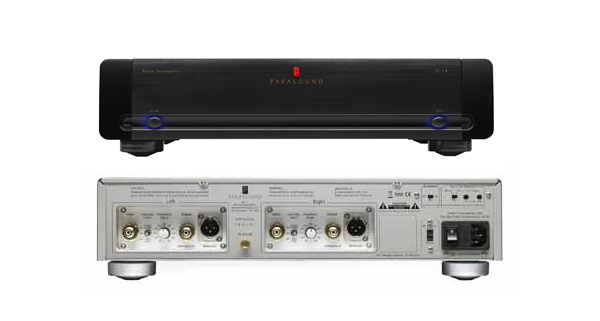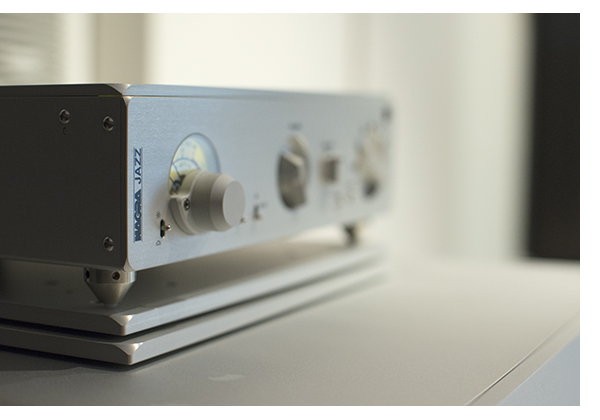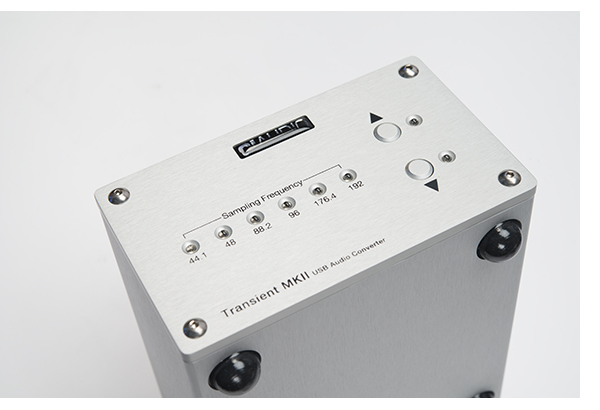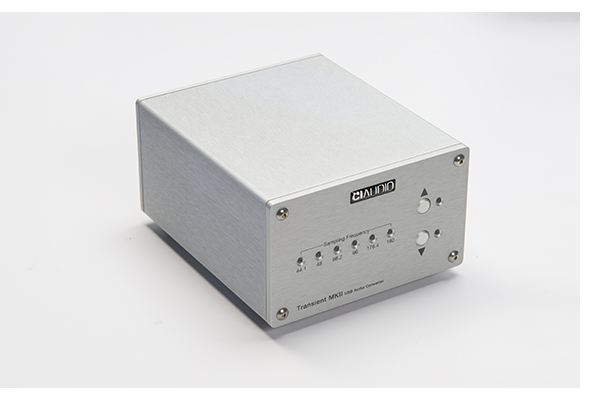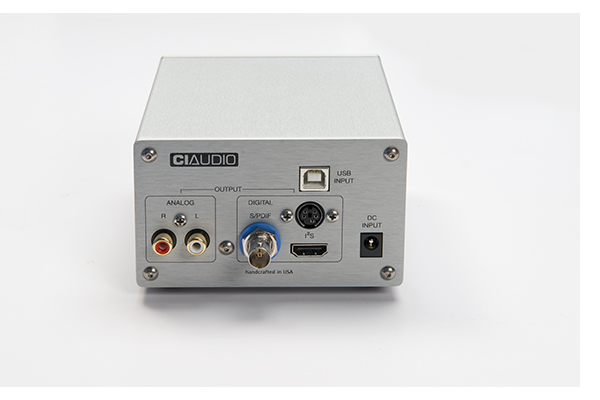 McIntosh has always built preamplifiers that define the term “input flexibility,” which is why I always refer to them as control centers. With nine inputs and six variable outputs (two XLR and four RCA) in addition to a processor loop, it’s safe to say this preamplifier should be able to accommodate every source in your system. It also features a MC and MM phono stage that can be configured from the front panel or your remote control, so no stone is left unturned. MSRP for the C500 is $12,000 in either the solid-state or tube version. You can buy all three boxes for $18,000, but the C500 controller can only access one preamplifier at a time.
McIntosh has always built preamplifiers that define the term “input flexibility,” which is why I always refer to them as control centers. With nine inputs and six variable outputs (two XLR and four RCA) in addition to a processor loop, it’s safe to say this preamplifier should be able to accommodate every source in your system. It also features a MC and MM phono stage that can be configured from the front panel or your remote control, so no stone is left unturned. MSRP for the C500 is $12,000 in either the solid-state or tube version. You can buy all three boxes for $18,000, but the C500 controller can only access one preamplifier at a time.
A two-box design, the C500 has an interesting twist for those having the age-old debate about the validity of solid state versus vacuum tubes; you can configure your C500 either way. It’s actually two preamplifiers, the C500P (solid state) or C500T (tube). The flagship C1000 controller offers the same choices and allows you to drive both preamplifier modules simultaneously, but with the C500, you have to draw a line in the sand and pick one. For those on the fence, your McIntosh dealer should be able to audition both.
While McIntosh does an excellent job at voicing their gear similarly, there is still an elusive magic to the tube sound that is tough to ignore, and while a vacuum-tube preamplifier means that you will have to change tubes from time to time, it’s nice to have the option. The end user is the winner thanks to this unprecedented ability to fine-tune your system, even to the all-McIntosh customer. And both two-box designs feature a set of big, blue output-level meters.
A fully balanced design from input to output, the C500 uses eight 12AX7 tubes: four in the high level circuit and four more in the phono preamplifier. The phono preamplifier circuit is all tube if you are using the moving magnet (MM) stage. If you have a lower-output moving-coil (MC) phono cartridge, the MC stage uses McIntosh’s own solid-state phono step-up modules instead of an input transformer. Four of the 12AX7’s are visible from the front panel, back lit in green, while the other four are beneath the top cover.
Setup
The controller section of the C500 has no tubes inside and generates almost no heat, but the preamplifier section does get a little bit warm with eight tubes inside, so make sure to give it some ventilation room. Once both boxes are unpacked, you will notice a pair of umbilical cords that look like parallel-interface printer cables from the earlier days of PC-based computing. According to Ron Cornelius, McIntosh’s Sales Manager, there are only control voltages running through these cables; “There are no audio signals here.” So for the tweekophiles in the audience, put your fears aside.
The single IEC power socket is located on the controller chassis, which also houses the dual power supplies for each channel, making the C500 a true dual-mono design. For those new to the McIntosh fold, these power transformers are wound in-house, as they always have been.
Once power is attached, the C500 stays in standby mode and on power up, displays a “tube warmup” message on the LCD front panel, with the outputs muted. Worth noting is that the C500 does not produce a harsh transient, should you forget and shut the preamplifier off before your power amp. A nice touch, especially should you be using an amplifier with significant power output.
If you are incorporating the C500 into an all-McIntosh system, there are seven individual data ports so you can link your other components to the C500 and control them all from the one remote – very cool if you have come to the point where you are considering hiring a feng shui consultant to keep your remotes in order! The C500 also features 12V trigger ports, so you can turn everything on with the single power switch. A great feature with other amplifiers but very impressive on a large McIntosh system when you see all of those blue and green faceplates light up at once.
Most of my listening for the review period was conducted with the MC275 vacuum-tube power amplifier and the MC1.2 KW solid-state monoblocks, and with a variety of speakers. The system was cabled entirely with Cardas Clear and utilized the balanced connections on all but one input (The dCS Paganini). After the initial listening was complete, I swapped the standard-issue power cord for a Python CX from Shunyata, as I use on my reference Burmester preamplifier.
How about that input flexibility?
It doesn’t stop with the number of inputs. The C500 allows you to trim the outputs of each program source +/- 6db and you can do it from the comfort of your listening chair, making it easy to fine tune the system so there are no surprises when going from CD to tuner, etc. Seeing that McIntosh has put so much effort into the display programming, it would be nice to see this taken a step further to let the user fully customize the input readout (a-la BAT or Simaudio). It would be great for those with multiple turntables and digital players to be able to have the display say “Rega P9” instead of “Phono MM.”
However, you can rename the inputs to the preset CD 2, Aux 2, etc. and you can shut off the display on the inputs that are not in use. So if you have only three inputs, you will only be switching between the active ones to avoid confusion. The display has seven steps of brightness from which to choose, and the meters can be switched off for those who like to listen in total darkness. But the question begs to be asked: why would you ever want to switch off the meters on a McIntosh?
The MM phono stage has adjustments for capacitive loading from 50pf to 750pf in 50pf increments. As there are a number of high-quality MM cartridges on the market, this allows to perfectly optimize your MM cartridge playback. The MC phono stage allows the input resistive loading to be set at 25, 50, 100, 200, 500 and 1,000 ohms. This should cover the bulk of MM cartridges that are available, but for the hard-core turntable enthusiast, it would be nice to see a “custom” setting that can be set by a competent technician.
Should you still own a high-performance tape deck or other recording device, the record and listen processor loops will come in handy. I found this to be indispensable using the Manley Massive Passive studio EQ, when capturing digital files from my favorite LP’s for music-server use. Thanks to the C500’s playback loop, I could sneak the Manley into the system to use with troublesome CD’s for playback as well. While this is a feature that few will use, those with multiple sources will appreciate it.
Definitely sounds like a McIntosh
Almost all McIntosh gear has a full-bodied sound that leans slightly to the warm side of neutral, but I can’t ever think of an instance where it isn’t welcome. I’ve heard other preamplifiers with more resolution, but the C500 offers a great balance between the lush, overly tubey sound of the ’60s and a modern high-resolution sound. While a few of your most pristine, perfectly recorded discs (analog or digital) may not have the last bit of slam and dynamics as they might on a more resolving preamplifier, I’ll bet that at least half of the records in your record collection will benefit from that extra tonal richness that the C500 offers. This is one of the main reasons for the fierce loyalty of McIntosh owners.
But don’t think the C500 doesn’t hold its own against the competition. When listening to the GamuT S9, the YG Acoustics Anat Studio II, the MartinLogan CLX and recently the Estelon XA (all very high-resolution speakers in the $30,000 – $140,000 range), I never felt the preamplifier was holding the system back.
When comparing to my reference Burmester amp and preamp, the tubes had a definite warmth, but it was always inviting. Male and female vocals came alive in a way that they only seem to do with tubes – there was just more of a third dimension available. Listening to Neil Young’s voice on the 24/96 version of Harvest was easily discernable from the standard 16/44 copies.
The soundstage of the C500 was always BIG. This seems to be so much easier to accomplish with vacuum tubes, and if you listen to a lot of rock and contemporary jazz that is created in a studio with a somewhat artificial soundstage to begin with, the C500 will win you over on this aspect alone. Listening to “Woman in Chains” from the Tears For Fears album, The Seeds of Love, the triangle played during the opening of the song appears to float about 10 feet beyond the speaker boundary. It’s not real, of course, but it is cool. If you love classic rock, you will be in heaven with the C500.
 Solid-State or Tubes?
Solid-State or Tubes?
By far, the most intriguing feature of the C500 is it’s ability to work with a vacuum-tube output stage or a solid-state one. As I suspected, the solid-state version had a bit more punch and the tube stage was slightly mellower. The solid-state preamp section also had slightly more weight in the lower registers. When listening to some bass-heavy tracks from Tosca, utilizing the JL Audio Gotham subwoofer, the tube section had a slightly looser feel, whereas the solid-state version offered a bass perspective that would more punch you in the chest. If you have a system capable of going down deep (the Gotham is only down -3db at 16hz) and perhaps listen to a lot of electronica, the solid-state version might be for you.
While I could happily live with either configuration, I did gravitate more towards the all-tube preamplifier with the MC 1.2KW solid-state monoblocks and the Octave MRE tube monoblocks (which are somewhat “un-tubey” sounding), while the solid-state output stage was more to my liking with the MC275 vacuum-tube power amplifier and my Conrad Johnson MV-50C1, which each have a fairly warm overall tonal balance.
Though definitely a great subject for a month-long internet forum argument, deciding which one of these two is right for you is immaterial. The good news is that you have the option. Should your needs change, you can go to your McIntosh dealer and purchase the alternative. Upon reconnecting all of your other components and the umbilical cord, a simple reset on the front panel and the C500 will make the necessary change.
Spinning records
C500 owners who have just one turntable and perhaps don’t swap cartridges often won’t be able to take advantage of one of this preamplifier’s best features: the ability to set loading from your listening position. Cartridge swaps are a weekly occurrence here, and many audiophiles will have removable headshells or tonearm wands that use a specific cartridge for different purposes or as the mood strikes. The more-involved vinyl junkie will be right at home with the C500.
I managed to try almost a dozen different phono cartridges from the Shure M97xe all the way to the Clearaudio DaVinci, all with excellent luck. The only cartridge for which I could not get the perfect match was the SoundSmith Sussaro, which is a moving-iron cartridge that sounds its best at about 2,500 ohms. There are a few moving-magnet cartridges that also perform a bit better slightly above or below the standard 47k loading, but these are the exception rather than the rule for 99.9 percent of analog users. Most MC cartridges should easily work between 100 and 1,000 ohms (though the 25 ohm setting is a fantastic match for the Rega Apheta MC).
Thanks to the solid-state modules in the MC section, the C500 is quieter than an all-tube phono stage and has a healthy dose of dynamic punch as well. A tiny bit of background noise creeps in to the C500’s phono stage, but you have to put your ear right up to the tweeter to hear it. The solid-state modules in the MC section aren’t just switched into the MM signal path. According to the engineers at McIntosh, there are two separate phono stages under the hood of the C500.
While listening to Joni Mitchell’s Wild Things Run Fast, (the recent ORG pressing), I found there was a wonderful midrange bloom to the presentation that made Mitchell’s voice take over the soundstage in a very enjoyable manner. I had similar results with any other strong vocalists in my record collection. Playing Marquise Knox’ Man Child on LP was a chilling experience, revealing enough of his vocal character that you just might be fooled into thinking that you are back at Chad Kassem’s Crossroads Blues Festival.
Comparing the phono stage in the C500 with some of the outboard phono stages we’ve had the opportunity to live with during the past few years, it offers a level of performance that would cost you $2,000 – $3,000 in an outboard phono stage. A separate MM and MC stage is pretty much non-existent at this price, plus you probably would want to buy an upgraded power cord along with a pair of decent interconnects going from phono stage to linestage.
Don’t forget the phones
McIntosh doesn’t ignore the headphone users on any of their preamplifiers, and the C500 is no exception. While not the last word in headphone performance, you would have to spend somewhere between $500- $1,000 to get an outboard headphone amp (and remember, more cables….) to put this one in the weeds. Running the gamut of the AKG 701’s, Grado GS-1’s, Sennheiser 650’s and my new favorites, the Audeze LCD-2’s, I came away impressed with the C500’s performance.
The headphone stage sounded identical on both output sections, leading me to believe that the phono board is identical in each. Though it would only benefit a small number of customers, it would be cool to run the tube output stage direct through the phones. If you are like me and enjoy headphone use from time to time but don’t feel the need to invest in a multi-thousand-dollar headphone setup, the C500 should serve your needs just fine.
 Looks great, sounds great
Looks great, sounds great
McIntosh has stayed true to its look and feel, so the big, backlit glass front panel and blue meters will either speak to you or they won’t. The C500 is rock solid. It’s been playing here for about the past six months, 12 hours a day without so much as a burp, and I suspect that it will continue to do so just as so many McIntosh preamplifiers do out there in the world.
The best reason for buying this preamplifier is its combination of performance and flexibility. Whether you ultimately make one the cornerstone of your system depends on whether you can make use of what it offers. There are a few $12,000 linestages out there that will extract more music from your recordings, but none of them have a built-in MM and MC phono stage, or a built-in headphone amp. So the C500 ends up being a little spendy if you don’t need the phono stage and a killer bargain if you do. It’s also nice to know that should your amplification needs change, you can fine tune the C500 with some tube rolling or even change the output stage to solid state. -Jeff Dorgay
McIntosh C500 Control Preamplifier
MSRP: $12,000 – $18,000
www.macintoshlabs.com
Peripherals
| Analog Sources |
Rega P9/RB 1000 and Shelter 501II cartridge Oracle Delphi V/SME 309 Grado Statement cartridge |
| Digital Sources |
dCS Paganini stack Sooloos Music Server Naim HDX |
| Power Amplifiers |
McIntosh MC275 McIntosh MC1.2kw monoblocks Octave MRE 130 monoblocks Burmester 911 mk.3 Pass Labs First watt F2 Conrad Johnson MV-50C1 |
| Cable |
Cardas Clear speaker cable and interconnects |
| Power |
Running Springs Dmitri and Maxim power conditioners RSA and Shuynata power cords |
| Speakers |
GamuT S9 MartinLogan CLX YG Acoustics Anat II Professional Estelon XA B&W 805D w/JL Audio Gotham subwoofer |
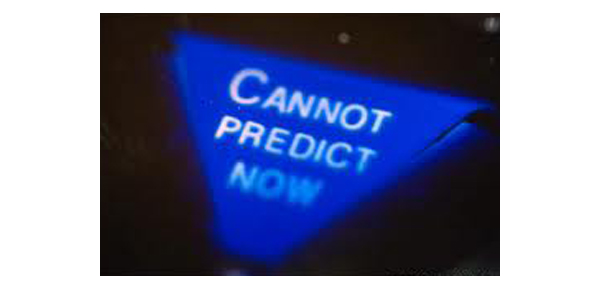 My challenge to my colleagues for 2014? How about some insightful commentary, instead of just going for the low hanging fruit. Remember, almost all of you were right there proclaiming (with equal certainty) the death of analog twenty years ago.
My challenge to my colleagues for 2014? How about some insightful commentary, instead of just going for the low hanging fruit. Remember, almost all of you were right there proclaiming (with equal certainty) the death of analog twenty years ago.



